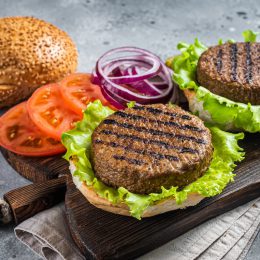The Five Rules of Good Nutrition
Healthy eating is a topic that’s hotly debated. But these proven principles of good nutrition will help you age better and feel more energized.

There’s a lot of nutrition research that seems to contradict itself. One day you hear that a food is “bad” for you, and the next it’s “good” for you. Is saturated fat the villain or are carbs the worst? The world of food science is ever-changing, and it’s tough to keep it all straight.
This can make it a challenge for dietitians like me to provide clear answers on what to eat for better health. The best diet depends on someone’s physiology, age, health, cultural food preferences, budget, and personal beliefs. Which means there is no one perfect way to eat, despite what some fad diets want you to believe.
But there are several guidelines you can feel confident about. Almost everyone in the medical and nutrition field agrees on these five principles for nutritional gains and healthier aging.
Healthy eating and fitness go together! SilverSneakers classes and events are happening daily at participating gyms, online through SilverSneakers LIVE, and at community centers near you. Activate your free online account to get started.
Rule #1: Eat the Rainbow
For better health, dietitians almost universally say you should fill your plate with an assortment of colorful vegetables and fruits. The pigments in produce are powerful antioxidants that can keep our bodies operating more smoothly. Antioxidants are compounds that protect our body’s cells and lower the risk for many serious diseases.
The different colors of fruits and vegetables provide different antioxidants with varied benefits. Orange carrots and sweet potatoes get their hue from beta-carotene, which is important for vision and eye health. Red tomatoes contain lycopene, which may protect against heart disease and certain types of cancer. Blueberries supply a hefty dose of the anthocyanin compounds may help boost your brain health.
So the more colorful your diet, the more protection you have against disease. A study from Colorado State University found that women who ate a greater diversity of fruits and vegetables experienced lower levels of DNA oxidation, which is a sign of accelerated aging.
Your Action Plan:
- Put at least five different colored fruits and veggies in your cart every time you go grocery shopping.
- Find new ways to add color to your meals and snacks. Stuff a sandwich with spinach and sliced red bell pepper; top oatmeal with assorted berries; roast sweet potatoes and Brussels sprouts for a dinner side; and add dried fruit to salads.
Rule #2: Limit Added Sugars
Nutrition and health experts agree that the outrageously high amounts of added sugar in the modern American diet is bad news. Consuming too much added sugar — sweeteners like high fructose corn syrup and cane sugar that are found in everything from yogurt to pasta sauce —has been linked to a growing number of health problems.
A large study in the American Journal of Clinical Nutrition found that people who eat higher intakes of added sugar were at a greater risk of developing coronary heart disease. But this connection wasn’t found with higher intakes of natural sugars found in fruits and vegetables.
One reason why added sugar is so problematic is that it provides calories without nutrients. This makes it harder to achieve a healthy body weight and maintain good health. (Learn more about the importance of nutrient-dense foods here.)
According to the U.S. Dietary Guidelines, older adults should keep their added sugar intake to less than 10% of their total daily calories. It’s easy to eat twice that amount without realizing it.
Your Action Plan:
- Eat naturally sweet foods like fresh or dried fruit.
- Read food labels carefully and look for products that list low amounts of added sugar.
- Go easy on desserts and sweet snacks.
- Sip unsweetened beverages like water, coffee, and tea.
Rule #3: Eat Enough Protein
Protein is one of the three macronutrients, along with carbohydrates and fat, that are the nutrients we need in larger quantities to provide us with energy. Many older adults struggle to get enough protein, in part because foods with higher carb and fat content cost less. But it’s the macronutrient that healthy aging experts strongly recommend for everyone.
Our bodies need amino acids (protein’s building blocks) to produce important molecules like enzymes, hormones, and neurotransmitters. When we don’t eat enough protein, our bodies take it from our muscles, which weaken them.
Sarcopenia is the age-related progressive loss of muscle mass and strength that can reduce our ability to perform daily tasks. It also sets us up for frailty, falls, and fractures. But research suggests a higher protein diet, especially when paired with regular resistance-training, may help older people build and maintain muscle. It also helps you feel full longer and can help with your weight-management goals.
The right amount of daily protein depends on your age, gender, and participation in weight training. The recommended dietary allowance (RDA) for protein for older people is 0.8 g protein per kilogram body weight each day. So, a person who weighs 165 pounds should consume 60 grams of protein a day. But most experts say eating more than this amount is beneficial for muscle mass and function.
Your Action Plan:
- Eat higher-protein foods like poultry, fish, dairy, and tofu in each of your meals.
- Consider boosting intake with a protein powder.
- Work with a dietitian to help you fine-tune your protein goals and make the necessary dietary changes to get enough of it.
Recommended reading: 10 Ways to Sneak More Protein Into Your Diet
Rule #4: Go Easy on Fast Food
It’s convenient, tastes good, and it’s reasonably cheap, so it’s no surprise it’s popular. But you aren’t likely to find many health professionals who say it’s OK to frequently indulge in cheeseburgers, fried chicken, and onion rings. Fast-food meals are often high in sodium, saturated fat, refined grains, and added sugars. They are also low in fiber and antioxidants. Many places do offer healthier options, but they’re the minority of menu items.
That unhealthy food takes a toll. Researchers from the University of Iowa looked at the association between eating out and death rates. Eating away from home leads to an increased risk of death. And another study found that people who order fast-food regularly don’t tend to eat any healthier when they are eating in.
No food pro would deny you an occasional order of fries, but the key approach is to balance an occasional fast-food indulgence with overall healthy eating patterns.
Subscribe to our newsletter
It's quick and easy. You could be one of the 13 million people who are eligible.
Already a member? Click to discover our 15,000+ participating locations.
Follow Us
Your Action Plan:
- Limit your intake of fast-food to only a few times a month.
- Prepare more of your own meals.
- Find the fast-food menu items that are healthiest. Most establishments provide detailed nutrition information for their meals.
Rule #5: Eat Mindfully
Not paying attention to what you eat makes it easy to put too much food in your mouth. That’s why mindful eating is praised as a way to build a healthier relationship with food.
This style of eating centers around being present in the moment when you consume food. You’re encouraged to fully tune into your thoughts, emotions, and physical sensations. You learn to listen to your body’s own cues to decide what, when, and how much to eat.
That heightened awareness will make you appreciate your food more and follow your body’s natural hunger cues. Wolfing down a meal in front of the TV does not give your brain a chance to register pleasure — or recognize when you’re full.
Research has shown that people who practice mindful eating are less likely to be overweight or obese, and mindfulness interventions can also lower cravings for unhealthy foods.
Your Action Plan:
- Take a minute or two before having a meal or snack to ponder how famished you really are.
- Unplug from TVs and smartphones and sit at the table to avoid distractions.
- Savour each bite of your food for several seconds to appreciate the flavor, aroma, and texture.
- Put down your utensils half-way through a meal and check in with yourself. Are you already full? Then stop eating and take pleasure in the food you’ve already enjoyed.
Recommended reading: 10 Things That Can Happen When You Stop Dieting
See our sources:
- Antioxidants and disease protection: The Journal of Nutrition
- Added sugar: The American Journal of Clinical Nutrition
- Restaurant food and mortality rates: Journal of the Academy of Nutrition and Dietetics
- Dietary protein and muscle function: Nutrients
- Fast-food and overall diet quality: Journal of the Academy of Nutrition and Dietetics
- Mindful eating: Obesity
Check Your SilverSneakers Eligibility Instantly
SilverSneakers members can go to thousands of nationwide gyms and fitness locations, plus take SilverSneakers LIVE online classes that are designed for all fitness levels and abilities. If you have a Medicare Advantage plan, it may include SilverSneakers — at no additional cost. Check your eligibility instantly here.
Already a member? Get your SilverSneakers member ID and exclusive fitness and wellness content by activating your online account here.
Not eligible for SilverSneakers? You can still get 200+ free SilverSneakers On-Demand videos and stay in touch with us by creating your online account.





